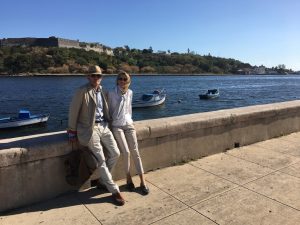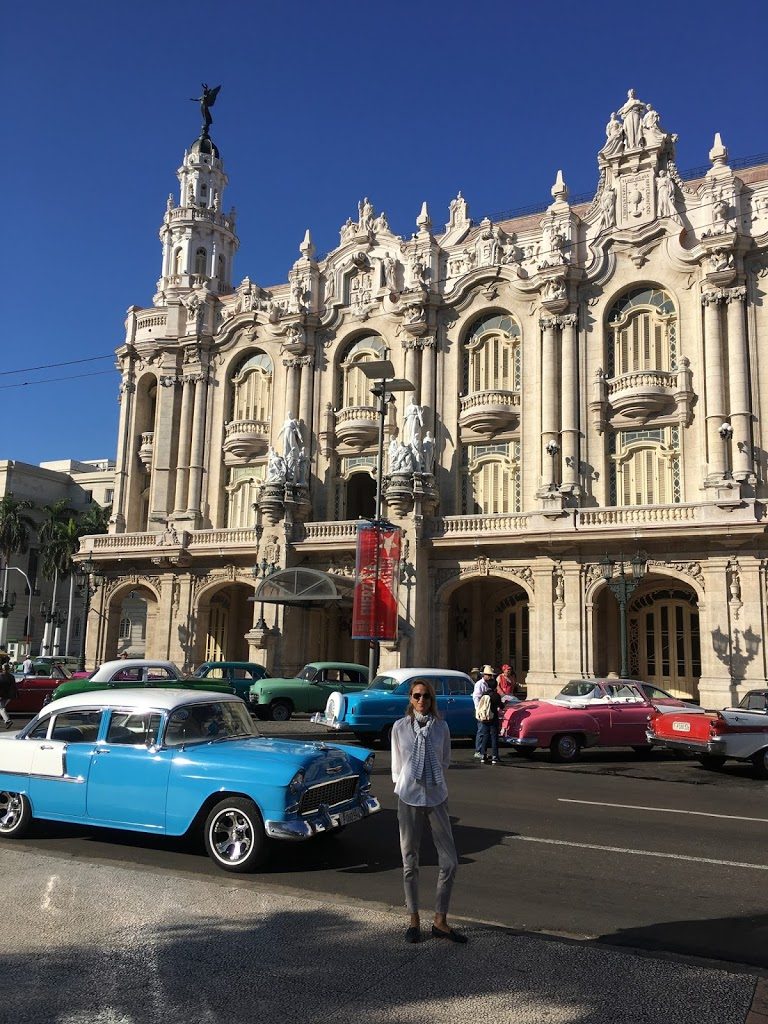 |
| Gran Teatro |
We recently enjoyed a ‘city break’ to Havana, Cuba for my big zero birthday – a trip full of contrasts and new experiences, peppered with unexpected eccentricities. Our first morning was spent with a local Cuban, Michael (ironically named after the US king of pop), who took us on a comprehensive four-hour tour of Old Havana, local-style – with the odd tourist spot thrown in.
 |
| José Marti in Parque Central |
Our tour began in the restored part of Old Havana, at Parque Central (albeit more of a square) followed by the smart tree-lined El Prado, which was the first street built outside the city walls in the 18th century.
This sophisticated area, once popular amongst Havana’s bourgeoisie, was certainly not what I expected to find in Cuba. Not unsurprisingly, it continues to be an attraction for tourists and residents alike, with its beautifully refurbished European–style mansions and hotels, together with the Gran Teatro and domed Capitolio (modelled, again ironically, on Washington’s Capital Hill).
 |
| Old Spanish Forts |
However, it was quite apparent that the average tourist doesn’t choose the ‘walking’ tour option, as we were very much alone on El Prado and, likewise, as we made our way down to the water front to view the 16th century Spanish forts and contemporary monuments. The line of coaches, parked within easy access to Old Havana’s notorious plazas, displayed the more popular form of travel and prepared us for imminent company.
 |
| Plaza de la Catedral |
 |
| Conversación |
The plazas in question are indeed picturesque, each with an interesting mix of 16th – 20th architecture authentically renovated, including mansions, a cathedral and basilica, as well as ‘Conversación’, a poignant modern sculpture donated by the French ambassador in 2012.
There are sufficient side streets surrounding and connecting these squares to disperse any potential crowds, making it less of a tourist trail; and some were uncannily deserted.
 |
| Tacón |
The more popular sites were those that Hemingway frequented. My romantic intention of paying homage to Mr H was doomed when greeted by crowds with a similar idea. This renowned author may have famously asserted ‘My mojito in the Bodeguita del Medio and my daiquiri in the Floridita’, but I am sure he would have equally turned on his heels on seeing the most unlikely of literary crowds frolicking in his favourite haunts!
As Michael led us off the beaten track, the dilapidated buildings became more apparent. There was little sign of restoration, save a few attempts here and there – either work in progress or simply abandoned. The once–prized architecture appeared to be clinging on for survival – it was not just the plaster that was crumbling, but whole structures looked decidedly bombshelled!
The decay starkly contrasted with the pristine plazas, and yet such buildings still held a certain charm in their quest for survival, with the crude maintenance and brightly coloured facades reflecting the positive resilience of their Cuban inhabitants.

 Our apartment was one of the lucky buildings that had been partly restored, with whitewashed walls and wrought iron balconies, contrasting with the ground floor’s iron cladding embellished with graffiti. The apartment itself was light and bright and simply yet tastefully decorated, with tall windows, high ceilings, traditional fans and marble floors – just how I imagined an apartment in Havana to be. And a big plus was the great Italian coffee maker – albeit with strong Cuban coffee!
Our apartment was one of the lucky buildings that had been partly restored, with whitewashed walls and wrought iron balconies, contrasting with the ground floor’s iron cladding embellished with graffiti. The apartment itself was light and bright and simply yet tastefully decorated, with tall windows, high ceilings, traditional fans and marble floors – just how I imagined an apartment in Havana to be. And a big plus was the great Italian coffee maker – albeit with strong Cuban coffee!  |
| Chez Nous & El Dandy |
The apartment was located on the corner of the lesser–known Plaza Santo Cristo, named after the old Spanish style church on the north side of the square. Its rather plain interior was enhanced by the newly restored stained glass windows, which were impressively radiant in the sunlight.
The plaza was very much full of every day Cuban life, echoing with children’s voices from the church school every morning and afternoon. It was also a thoroughfare for bicitaxis winding in and out of the Trabants, Ladas and vintage cars, all vying for trade. Whilst the local folk strolled with intention, unless distracted by the occasional street seller’s sweet pastries – or bananas if they were lucky.
 |
| Plaza Santo Cristo |
The pièce de resistance of the square was El Dandy – a true happenstance just across the street from the apartment, which was not only to become our ‘local’, but also a saving grace as we experienced the infamous limitations of this poor country.


